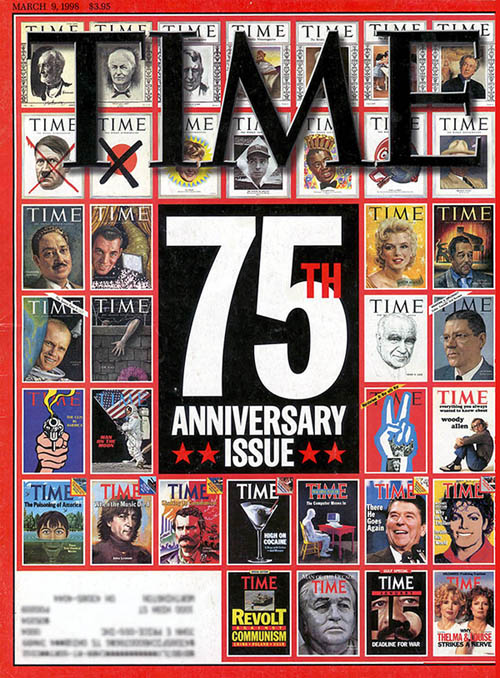75 Years of Time
Today, 75 years of Time. The University of Houston's College of Engineering presents this series about the machines that make our civilization run, and the people whose ingenuity created them.
Time magazine is only seven years older than I am. So I was given a copy of its diamond jubilee issue as a 75th birthday gift. Time had been a constant presence as I grew up. It summarized the political and social world that surrounded me.
Life magazine joined Time in 1937. It became Time's broader and more visual cousin. You can still find copies of each in magazine racks, but they no longer have anything like the importance they once had. That role has passed on to TV networks.
This special 1998 edition reprints articles on, and pictures of, political events, entertainers, daily life, and social upheaval, since 1923. Only the advertisements are current, and from this vantage point, even 1998 looks antiquated. You still see a Marlboro man, but with a hat obscuring his face. (By then, two of the known Marlboro men had already died of lung cancer.)
We read letters to the editor from Upton Sinclair, Pearl Buck, Salvador Dali, William Randolph Hearst and Orson Wells, Aldous Huxley and Ronald Reagan. In those days Time had sufficient stature that you didn't ignore it when it misrepresented you. Harpo Marx writes to say that he can indeed talk, but that he hates interrupting Groucho. A 1925 letter from a man in Aiken South Carolina protests Time's use of the title mister, in addressing Negroes.
So we watch history unfolding. A 1924 article shows 35-year-old Adolph Hitler after the Beer Hall Putsch -- his failed attempt to declare himself Chancellor of Germany. The article mocks him, without realizing how oppression can arrive on little cat feet.
In 1929, we read about Fox Film's announcement that it'll henceforth make only talkies. The silent movie is doomed. Seven months later, a small article reports continuing failures of companies on the Stock Exchange; it's the sixth day of the Great Depression. We read about the Spanish Civil War, the Invasion of Poland, Pearl Harbor, WW-II. My childhood marches on.
So what about the technologies shaping civilization below its noisy surface? They're there, like a seed beneath the snow. Arti-cles from the late '50s describe the explosion of cheap domestic architecture and cars with big tailfins. We read about Buckminster Fuller's geodesic dome houses. And, in that era, the threat of the The Bomb always hovers. But the magazine seems more focused on people than on their machines. Charles Lindbergh and Bill Gates each looms large in his time.
So I turn pages and I watch my own life unfolding. I remember where I was when this happened, what I was doing when I read that article. From beginning to end, I'm looking into a mirror.
I especially like the letter from Maureen O'Sullivan with a clarification about the Tarzan movies I watched as a child. Johnny Wiesmuller did indeed utter his famed yodeling call through the jungle, she tells us. That was no voice-double. And I have to say, I was very glad to have that cleared up at last.
I'm John Lienhard, at the University of Houston, where we're interested in the way inventive minds work.
Time. Vol. 151, No. 9, March 9, 1998.
